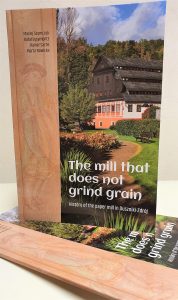The mill that does not grind grain
In late December 2019, the Museum of Papermaking issued a publication titled “The mill that does not grind grain. History of the paper mill in Duszniki-Zdrój”. The publication, referred to by the Duszniki museum workers as “the small monograph”, was published in Polish with a print run of 5 thousand copies. It is distributed free of charge among museum guests. Its authors are Prof. Maciej Szymczyk, Rafał Eysymontt, Rainer Sachs and Marta Nowicka. Precisely one year after the event, the publication was translated into English and printed in 2000 copies. The book “The mill that does not grind grain” is also available in electronic version.
…
The publication consists of six chapters, devoted, among others, to the development of handicraft paper production, owners of the paper mill in Duszniki, and its architecture and significance for tourism.
It is the only paper mill in Poland that has been the seat of the Museum of Papermaking for over 52 years. One of the chapters discusses its collections, recently supplemented by an extremely rare 1000 zloty note dating back to 1794.
A paper mill calendar was also published in “the small monograph”. It permits one to trace the individual stages of the paper mill’s efforts to be included on the UNESCO list. Currently, the paper mill in Duszniki is included in the information list (Tentative List). Historical paper mills from the Czech Republic (Velke Losiny), Germany (Homburg) and France (Ambert) are also seeking entry under the direction of the Museum of Papermaking. Subsequent activities will be aimed at preparing a joint international application for inclusion in the UNESCO list, covering the most valuable historical paper mills from Poland, the Czech Republic, Germany, France and possibly other countries. Inclusion on the UNESCO list involves a considerable increase in the number of visitors, including foreigners. They are the reason why the museum’s publications are being translated, including the last item on the history of the paper mill, entitled “The mill that does not grind grain”.
The publication is financed by the Lower Silesian Voivodeship self-government as part of efforts to include the paper mill in the UNESCO World Heritage List.
Pdf for download below
The mill that does not grind grain


